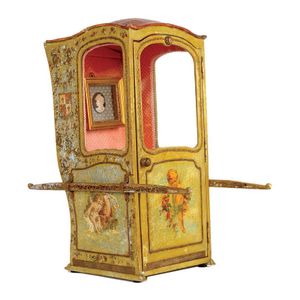Venetian Sedan Chair with Putti and Coat-of-Arms
You must be a subscriber, and be logged in to view price and dealer details.
Subscribe Now to view actual auction price for this item
When you subscribe, you have the option of setting the currency in which to display prices to $Au, $US, $NZ or Stg.
- Putto / Putti / Amorino / Amorini - A putto (plural: putti) or amerino (plural: amerini) is a cherub or cupid frequently appearing in both mythological and religious paintings and sculpture, especially of the Renaissance and Baroque periods and later used as a decorative element in the design of furniture, ceramics, statuary etc. They are usually depicted as chubby males, or of indeterminate gender, often with wings. Their depiction may represent an association with love, heaven, peace or prosperity.
- Crackling and Crackle as a Decorative Technique - Crackle, also known as crackling, is a decorative technique that has been used in China for centuries. It is believed to have originated during the Song Dynasty (960?1279 AD) and was primarily used in the production of ceramics, lacquerware, and furniture. The crackling effect was achieved by applying a glaze or lacquer that was formulated to crack during firing, creating a crackled pattern on the surface of the item.
During the Ming Dynasty (1368?1644 AD), crackle became a highly sought-after decorative technique, and it was used to create intricate and beautiful designs on ceramics and lacquer ware.
In Western decorative arts, crackle / crackling came into use during the Art Nouveau movement in the late 19th and early 20th century. The crackling effect was used to create a sense of movement and fluidity in the design of Art Nouveau pieces.
It was also used in the 1920s and 1930s during the Art Deco movement.
This item has been included into following indexes:
Visually similar items

A late 19th century French gilt brass carriage clock, c.1890, in a Corniche style case with white enamel dial and Roman numerals. Silvered platform with bi-metallic balance and lever escapement. Height 145 mm. Makers mark AM (running).

A 19th century French ormolu and champleve enamel small bombe mantel clock, the case in decorative powder blue dominated enamel florals, the white enamel dial with painted floral swag and Arabic numerals, enclosing diamante bezel, the French movement worki

A late 19th century gilt brass carriage clock, with Corniche style case, white enamel dial with Roman numerals and alarm subsidiary dial on bell strike. Platform cylinder escapement. Height 145 mm (running).

A French brass carriage clock, with key
